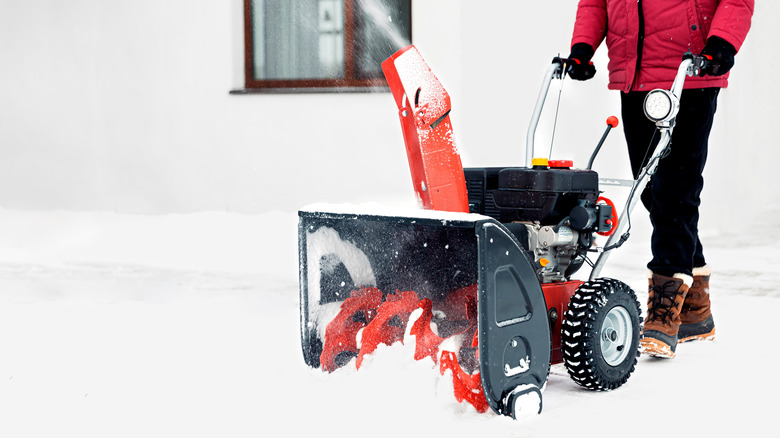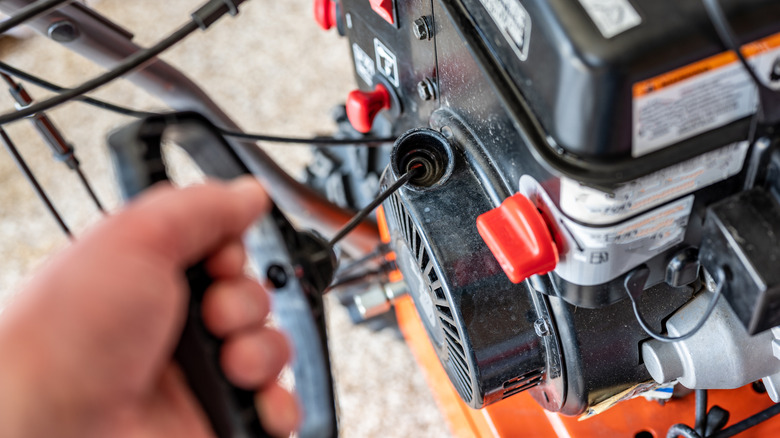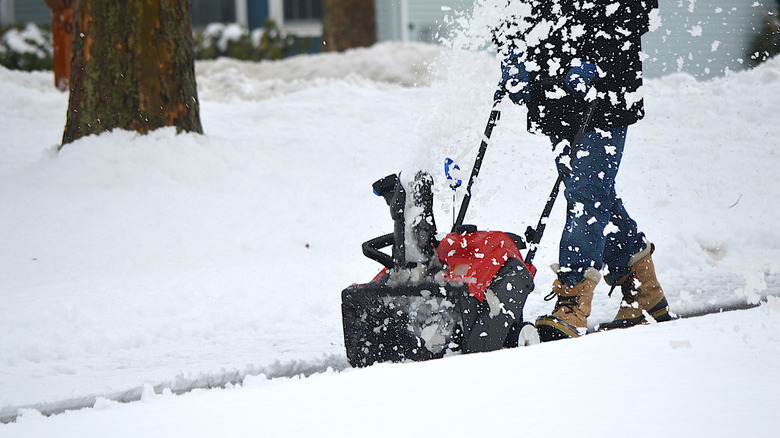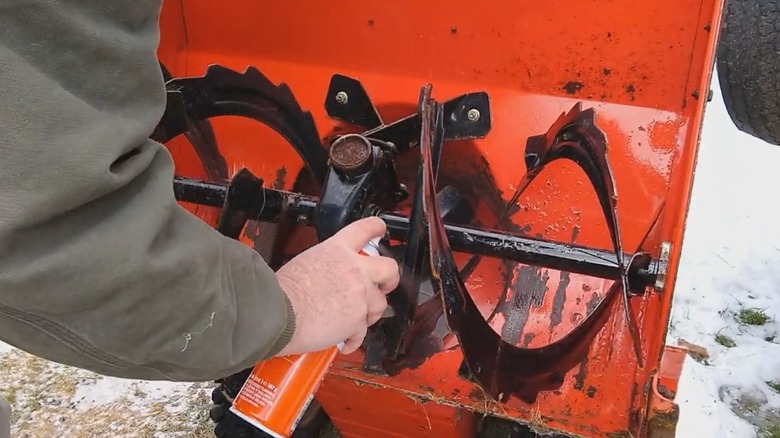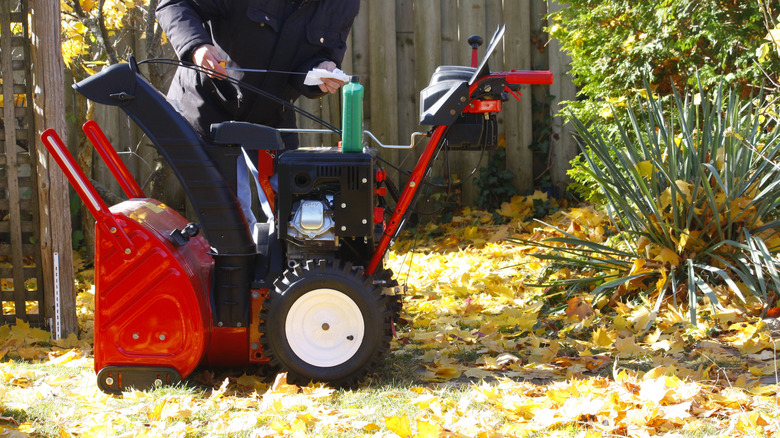Snow Blower Safety Tips To Keep In Mind In Winter (And Common Mistakes To Avoid)
We may receive a commission on purchases made from links.
Clearing snow from walkways and driveways is one of the most annoying aspects of winter. Snow blowers can make the task much more manageable, especially if you pick one of the top-rated snow blowers to keep your walkways safe. However, like all tools, snow blowers can be dangerous if used incorrectly. To avoid any problems this winter, you can follow basic safety guidelines like giving your snow blower a proper tune-up and avoid blowing around snow recklessly to spare your neighbors from any accidents, too.
On the surface, snow blowers might not seem like a dangerous tool. They're just moving snow, after all. However, your snow blower includes parts like a spinning auger, serrated metal blades that can cause injury. The United States Consumer Product Safety Commission estimated that snow blowers result in about 5,740 emergency room visits each year. The most common injuries include broken bones, lacerations, and sprains, with about 11% of cases resulting in finger amputation, according to a study published in Cureus.
You can avoid making some of the most common snowblower mistakes by simply reading your manual before use. In addition to providing a rundown of your specific model, a manual often provides guidance on common issues like blockages. Before breaking out your machine, prepare your snow blower for winter with a pre-season check-up, including inspecting the spark plug and lubricating parts. If you have a gas-powered machine, you should also check your oil and add fresh gasoline. Then, give it a test run to ensure everything is in working order.
Prepare the area and start your snowblower properly
Before getting started, scour the yard to remove any debris like branches, pet toys, newspapers, and more from your working area. This step is extra important because most injuries occur when people try to incorrectly remove clogs from their snow blowers' chute or augers. When in use, establish a safety zone, as your snow blower can still chuck undetected debris like rocks up to 30 feet away. Keep bystanders, especially children, at least 75 feet away. A snow blower is powerful, and it can easily suck in clothing like a jacket hood or scarf, so be sure that you are dressed appropriately whenever you're working outside. This means wearing safety glasses and closed footwear with traction and avoiding any loose clothing. You should also avoid wearing headphones so you can remain aware of your surroundings.
Once you're ready to pull your snow blower out for use, there are a few more things to keep in mind. First, if you have a gas-powered machine, check that the tank is full before starting because you cannot add gas to a running or hot engine. If you forget this step and need to add fuel halfway through a job, let your engine cool for at least two minutes. Always start your snow blower outside to prevent carbon monoxide poisoning. For electric machines, plot out a path that will keep your electrical cord safe, and stay aware of its location at all times. You'll want to avoid tripping on it or accidentally running over it while working.
Use the snow blower responsibly
We've covered several of the things you should do before using a snow blower, but what should you avoid while working? Well, you should certainly avoid being a menace to your neighbors. When clearing your yard, be considerate of where you're blowing snow. You could cause damage to nearby buildings or vehicles if you blow snow their direction. In addition, you shouldn't blow snow into the street, as this can make driving less safe for motorists. Plus, snow plows may end up pushing it back onto your sidewalk again, which means you'll eventually need to deal with the same snow twice.
Lastly, you might come across hacks to disable your snow blower's "dead man's switch" for easier use. Ignore these. On a snow blower, the dead man's switch is often a handlebar that you need to squeeze during use. If released, it automatically stops your machine to prevent any accidents that could results in injury or death. This is done in case a person suddenly becomes incapacitated in any way and isn't able to shut down the snow blower themselves. You can also find a dead man's switch on a number of other machines including heavy equipment, lawn mowers, and chainsaws. Although it might seem annoying in the moment, this switch is a valuable safety device that shouldn't be tampered with.
Preventing and solving snow blower clogs
Even if you follow all safety precautions, your snowblower can still act up sometimes. One of the most common problems you'll run into with snow blowers are clogs. These can happen for a variety of reasons , such as debris or buildup, and is more common with certain types of snow. Icy or sticky snow may clog more than fresh, lightweight snow. In addition, if you move your snow blower too slowly, you will increase the likelihood of clogs, as slow-moving snow has more time to compact and stick to your snow blower's inner surfaces. To prevent clogs, wax or lubricate the chute and augers before starting the snow blower to help snow move along. You can purchase a special spray like DuPont Snow and Ice Repellant, but many hacks even suggest using a cooking spray or WD40.
Always turn the machine completely off before clearing a clog and never try to clear a clog with your hands. Because clogs are to be expected, many snow blowers come with an attached tool to help clear them. If you don't have this tool, you can also use a broom handle, long stick, or a similar sturdy object. To remove a blockage, you first need to turn off your machine. Wait at least ten seconds to allow the moving parts to fully stop. Then, use your tool to break up any snow, ice, or debris that is stuck in the chute. Even with the machine off, you should avoid sticking your hands or arms into it — the blades are still sharp, after all.
Prepare your snow blower before storing in spring
After winter comes to an end, it's time to tuck your snow blower away. Before doing so, you can take a few steps to make next winter easier. First, you should drain all of your existing fuel as gas can oxidize and break down over time. When gas breaks down, it results in a nasty sludge that will clog your snow blower's fuel tank, carburetor, and fuel lines. Your owner's manual should provide instructions on how to properly drain the fuel tank. Afterwards, make sure to run your snow blower until it stops on its own to ensure any leftover gas is gone. Many recommend emptying your tank even if you use a fuel stabilizer, but if you decide to store your snow blower with a stabilizer mix in the tank, make sure it is in a location that is safe from sparks or flames.
Once that is done, clean and thoroughly dry your snow blower. You can also spray any exposed metal parts with rust-prevention spray to prevent corrosion. This is also a good time to check for any worn parts that need replacing, making a note for yourself so it won't be a surprise come next winter. Finally, keep your snow blower in an area with low humidity to prevent corrosion, like your garage or shed. If either of those aren't available, you can purchase a snowblower cover, elevate it off the ground, and store it in an area that's safe from the elements.
